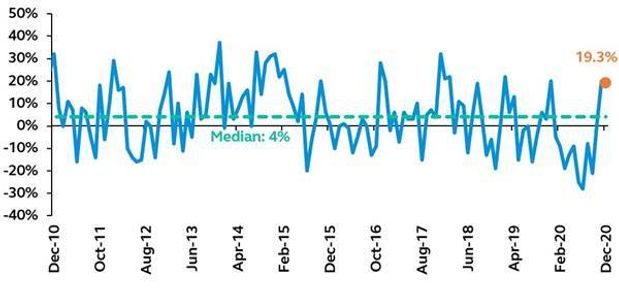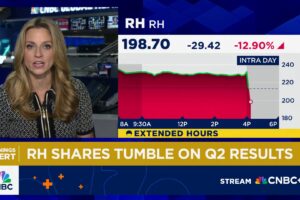A stark reality for the euphoric stock market? The coming week may present the closest thing to a reckoning for bullish investors so far in 2021.
It is the busiest week of the fourth-quarter earnings season, highlighted by hotly anticipated results from heavyweight companies like AT&T T, +0.35%, Apple Inc. AAPL, +1.61%, Facebook FB, +0.60% and Tesla TSLA, +0.20%.
In all, some 118 companies are scheduled to report quarterly results in the final trading week in January, including 13 components of the blue-chip Dow Jones Industrial Average DJIA, -0.57%, John Butters, senior analyst at FactSet research told MarketWatch.
And over 60% of that weekly onslaught will play out between Jan. 27 and Jan. 28.
The frenzied period could shape up to be a pivotal one for a market that may be searching for its next spark as the newly minted administration of President Joe Biden administration’s unfolds its policy initiatives and plans to tackle the COVID-19 pandemic.
Thus far, optimism is sky high among equity investors, with sentiment data from Ned Davis Research at a reading of 74.4%, a level that it has only achieved 7.4% of the time since 1994.
Similarly, the bull-bear spread is at 19.3% versus a median of 4% as of Dec. 31, according to American Association of Individual Investors survey.

Ned Davis Research says that the buying mood has apparently crushed the appetite for bearish bets that stock prices will face a meaningful near-term correction. “One thing that investors have been doing less of is short selling,” wrote analysts Ed Clissold and Thanh Nguyen in a Jan. 19 research report.
According to NDR data, the short selling ratio, the number of shares sold short divided by the total issues traded, hit its lowest since 2011 back in November.
One doesn’t have to search long to find evidence of the treacherous path that short sellers are facing these days.
Case in point, GameStop‘s stock GME, +51.08% is on track for its best monthly rise in its history, up 245%, as retail-investing fanatics touted the stock and urged users on finance-oriented social platforms like Reddit to buy the shares to squeeze activist investor and noted short seller Andrew Left’s Citron Research.
The actions of fanatic investor groups have gone beyond name-calling and hacking attempts and included what Left described as “serious crimes such as harassment of minor children,” MarketWatch’s sister publication Barron’s wrote.
For some, this is market ebullience at its apex. Short sellers cowering and retail investor bros trying to demonstrate their newfound might.
Is this what the precursor to a bubble feels like? Are we in one? When will it pop, if so?
The Fed
Those are all the questions that may be put to the Federal Reserve when it provides the backdrop to the other major event for next week: the latest monetary policy update.
Fed Chairmam Jerome Powell has often been blamed for both helping to prevent a calamity in financial markets during the onset of the coronavirus pandemic in March last year as well for fostering too much risk taking.
The Federal Open Market Committee, which Powell heads, rapidly slashed interest rates to near 0% and pumped trillions of dollars of liquidity into the financial market that had been rocked by COVID-19.
But the Fed’s policies have fostered some of the risk-taking on display, some critics argue. Bears also make the case that the endless money printing will have consequences for the U.S. dollar, for the economy and eventually financial markets in the long-run.
Biden is proposing an additional $1.9 trillion in federal government spending to help extricate the U.S. economy from recession as coronavirus cases and deaths reach a new peak this month.
All that may confer added significance to next week’s Fed gathering.
“All eyes will be on Chair Powell at next week’s FOMC meeting. We look for him to strike a more optimistic, yet cautious tone,” wrote economists Lydia Boussour and Gregory Daco of Oxford Economics, in a Friday research note.
In recent speeches, Powell has already indicated that the Fed isn’t eager to pull back on monetary policy accommodation soon, including raising interest rates from historic lows or tapering its asset purchases, a source of support for financial markets.
The Fed meeting kicks off on Tuesday, with Powell & Company delivering its policy update on Wednesday at 2 p.m. Eastern, followed by a news conference hosted by the chairman.
U.S. economic growth?
On Thursday, a day after the Fed’s decision, market participants will await the official report card on the health of the U.S. economy.
According to consensus estimates among U.S. economists polled by MarketWatch, the U.S. economy may have grown about 4% on an annualized basis in the final three months of 2020, which would be phenomenal ordinarily, but comes on the heels of a 33.4% increase in the third quarter.
Still, if the GDP reading continues to show upward progress, it may underscore that the economy is moving in the right direction even as the coronavirus pandemic continues to rage.
After all that is said and done if the Dow, the S&P 500 index SPX, -0.30% and the Nasdaq Composite COMP, +0.09% are still in spitting distance of record highs, the bulls may find themselves even more emboldened.


